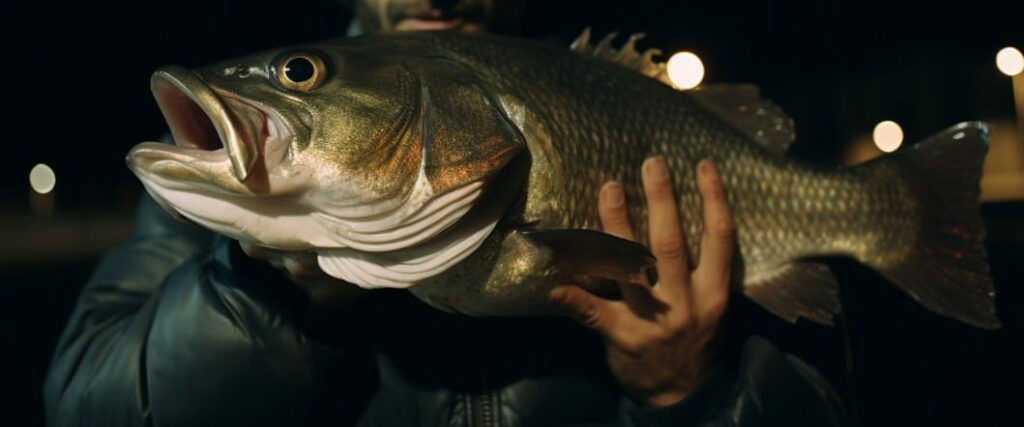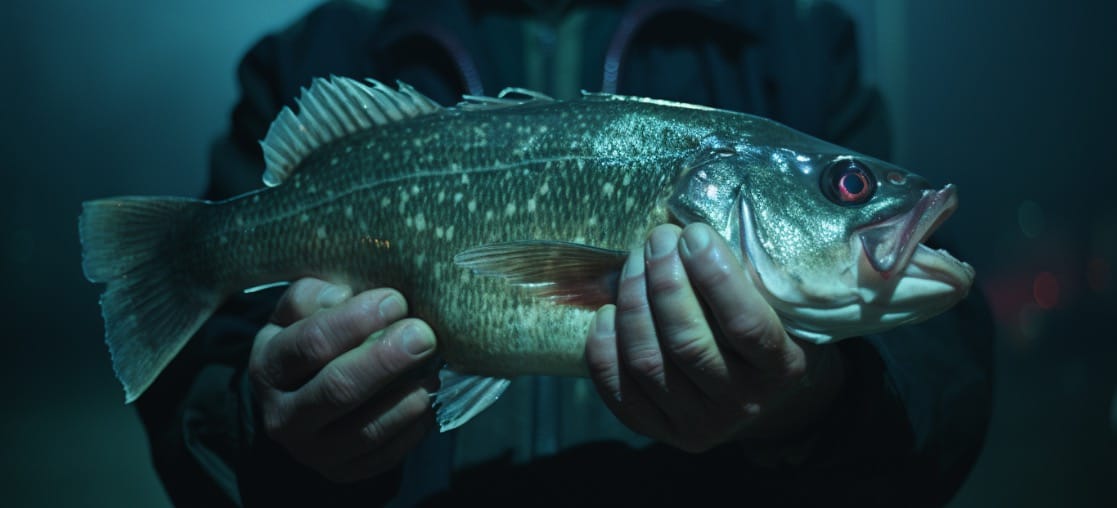Knowing how to fish for bass at night in ponds can be your secret weapon to maximize the enjoyment you take out of your fishing experience.
But how do you navigate the darkness to reel in that big bass catch?
In this guide, we’re diving deep into the world of night-time bass fishing in ponds.
Whether you’re a seasoned angler or someone who’s just getting started, this article is your comprehensive manual for mastering the art of catching bass under the moonlight.
Let’s get it going.
Understanding Bass Behavior at Night in Ponds

So, you want to catch bass at night in ponds, but before you even think about casting that line, you’ve got to understand what you’re dealing with which is why understanding bass behavior is essential:
Nocturnal Habits of Bass
First off, bass are opportunistic feeders.
During the day, they might be a bit lazy, hiding in the shadows, but come nightfall, it’s a different story.
They’re out and about, looking for a meal. They’re not vampires, but they do love the cover of darkness.
It gives them an edge over their prey, making it easier to ambush them.
Moon Phases and Temperature
No, this isn’t astrology; it’s fishing science.
The Moon’s Influence
The moon is more than just a celestial body; it’s a natural spotlight for night fishing.
When there’s a full moon, the added illumination makes it easier for bass to spot their prey. This increased visibility often leads to more activity and, consequently, a higher likelihood of them biting your lure.
On the other hand, when there’s a new moon, the sky is as dark as it gets. In these conditions, bass have to rely on their other senses like smell and their lateral line system to locate food.
They become less reliant on vision and more on vibration and scent, which means you’ll need to adjust your fishing strategy accordingly.
Temperature’s Role
Bass are cold-blooded creatures, meaning their metabolic rate is directly influenced by the water’s temperature.
In colder conditions, bass tend to be less active. Their metabolism slows down, and they’re less likely to expend energy chasing after food.
During these times, you’ll need to be more strategic with your bait and lure placement, as bass are less likely to go out of their way to bite.
Sensory Fishing: Beyond Sight
If you’re scratching your head, wondering how bass manage to find their dinner in the pitch-black night, you’re not alone. But here’s the deal: bass have a built-in advantage that you can exploit for successful night fishing. It’s called the lateral line system, and understanding it can be a game-changer for your fishing trips.
The Lateral Line System: Your New Best Friend
Bass have this incredible sensory organ known as the lateral line, running along the sides of their body. This isn’t just some random fish anatomy; it’s a tool that bass use to detect movements and vibrations in the water. When a smaller fish—or your lure—swims by, the lateral line picks up the vibrations, alerting the bass to a potential meal nearby.
How to Use This Knowledge to Your Advantage
Knowing that bass rely heavily on their lateral line system at night gives you a significant edge. You can choose lures that create more vibrations or even sound to attract bass. Options like chatterbaits, spinnerbaits, or even soft plastics that create a ripple effect can be highly effective. The key is to make your lure irresistible to the bass by appealing to their heightened sense of vibration and movement.
How to Catch Bass at Night in Ponds

Alright, you’ve got the bass behavior down, so let’s get to the meat and potatoes—actually catching these elusive creatures at night in ponds.
I’ve broken this down into five key areas that you absolutely need to know:
Importance of Timing and Weather Conditions
Before you even think about heading to the pond, check the weather forecast.
Look for stable weather conditions; bass aren’t fans of drastic changes.
Also, consult a moon phase calendar. Aim for nights with a full moon or at least a waxing gibbous for better visibility and more active bass.
If it’s a new moon, prepare to rely more on lures that appeal to the bass’s other senses like vibration and sound.
Identifying Prime Fishing Locations
Use a topographical map of your pond if available and try to identify structures like docks, fallen trees, and shallow areas. These are your hotspots.
Once you’re at the pond, start by casting around these structures as bass love to hang out near them because they offer excellent ambush points for catching prey.
Observe Everything
Don’t just cast your line willy-nilly. Take some time to observe the water.
Look for signs of fish activity like jumping fish, water ripples, or birds diving down to catch small fish. These are all indicators of where the bass might be.
If you’re not getting any bites, don’t be quick to change locations as sometimes it takes time for bass to move into an area to feed.
Using Artificial Light Strategically
Now, let me tell you about a trick I’ve used that works like a charm—artificial light.
If you’re like me and you fish from a dock or a boat, get yourself a submersible fishing light. I usually place mine about 3-5 feet below the water surface.
What this does is attract plankton, which then attracts baitfish, and guess who shows up for the buffet? That’s right, bass.
But here’s the kicker, you’ve got to give it time. I usually turn on the light and wait for about 30-45 minutes, that usually works.
Lure Selection: Beyond the Basics
I’ve spent countless nights experimenting with different lures, and here’s what I’ve found.
You want to go for lures that make a lot of noise and vibrations. I’ve had great success with spinnerbaits that have large, thumping blades.
The vibrations they create in the water are like a dinner bell for bass. Soft plastics rigged with a paddle tail are another go-to for me. The paddle tail creates vibrations that bass find hard to resist.
And if you’re fishing in a weedy area, don’t overlook a good weedless frog lure. The leg action on the retrieve has gotten me some of my biggest catches.
Choosing the Right Equipment

Alright, let’s talk gear. You can’t just show up with any old rod and reel and expect to haul in the big ones. Trust me, I’ve been there, and it’s a recipe for disappointment. So, let’s get you set up properly.
Essential Gear
I personally use a medium-heavy rod with a fast action tip as it gives me the sensitivity to feel those subtle bites and the backbone to set the hook hard.
For the reel, I go with a baitcasting reel with a high line capacity. You never know when you’ll hook into a monster, and the last thing you want is to get spooled.
As for the reel, I’m a baitcasting guy all the way, especially when it comes to night fishing.
The reason? Line capacity and control.
I opt for a baitcasting reel with a high line capacity because, let’s face it, night fishing is unpredictable. One minute you’re reeling in a small one, and the next, you’ve got a monster on the line that’s running like a freight train. The high line capacity ensures you won’t get spooled in the heat of the moment.
Bait and Lures
I’ve had nights where soft plastics were the ticket, and other nights where nothing but live bait would do.
For lures, I stick to ones that create a lot of vibrations. Spinnerbaits and chatterbaits are my go-to choices.
For live bait, I usually go with nightcrawlers or small shad. I’ve found that the natural scent and movement of live bait can sometimes be the difference-maker.
Line and Leader Material
Fluorocarbon Line: The Ghost in the Water
I can’t stress this enough: line failure at night is a gut-wrenching experience.
That’s why I always opt for fluorocarbon line when I’m out in a pond at night. This stuff is nearly invisible underwater, which is a huge advantage when you’re dealing with wary bass. They can’t see it, but they’ll definitely feel it when you set that hook.
But invisibility isn’t the only perk.
Fluorocarbon also has excellent abrasion resistance. When you’re fishing around submerged trees, rocks, or other structures often found in ponds, the last thing you want is your line to snap on a snag. Also, it gives me the confidence to fish in those tricky spots without constantly worrying about line integrity.
Heavy Fluorocarbon Leader: The Security Blanket
I go straight for a heavy fluorocarbon leader.
Why?
Because ponds often have a lot of underwater structure and cover where bass like to hide. A heavy leader gives me that extra bit of security when I’m pulling a bass out of a dense weed bed or from under a submerged log.
It’s like an insurance policy that ensures I land that fish instead of telling another “one that got away” story.
Hooks and Terminal Tackle
Don’t skimp on hooks and terminal tackle. I always carry a variety of hook sizes and types.
Circle hooks are great for live bait, while wide-gap hooks are perfect for soft plastics.
As for terminal tackle, a good selection of weights and swivels can come in handy. I usually bring along bullet weights for Texas-rigging and some split shots for quick adjustments.
Lights and Accessories
Last but not least, let’s talk about lights and accessories.
A good headlamp is a must as it keeps your hands free and makes tying knots and changing lures a breeze.
I also bring along a clip-on LED light for my tackle box, I can confidently say it’s a game-changer when you’re rummaging for that specific lure in the dark.
Techniques and Strategies for Night Fishing for Bass in Ponds

Alright, you’ve got the gear, you’ve got the bait, and you’ve picked the perfect pond. Now, let’s talk about the techniques and strategies that I personally use to make my night fishing trips in ponds a resounding success.
Advanced Casting Techniques
When I’m night fishing in a pond, I always go for a stealthy approach, especially with my casting.
To achieve this, I use a sidearm cast to keep my lure low and avoid making a big splash that can spook the bass.
The key here is to cast beyond your target and retrieve your lure through the potential strike zone. This technique has helped me land some of my biggest pond bass at night.
Retrieval Strategies
Retrieval is where the magic happens.
When I’m fishing at night in ponds, I slow down my retrieve considerably.
I mean, bass are more cautious at night, and a slow, steady retrieve can often entice a wary bass into striking.
I also like to add some pauses and twitches to mimic a wounded baitfish. Trust me, it drives the bass wild.
Using Artificial Light
I’ve already mentioned using a submersible light, but let me add a twist.
When I’m night fishing in ponds, I sometimes use glow-in-the-dark lures or add a small glow stick to my rig.
The subtle glow attracts curious bass and can make your lure stand out in the dark water.
Playing the Wind and Current: Nature’s GPS
Wind and current play a huge role when I’m deciding where to fish in a pond at night.
Bass often position themselves facing into the wind or current, waiting for food to come to them.
I cast into the wind and retrieve with it, using the natural flow to guide my lure into the bass’s strike zone. I’ve done this hundreds of times and it works like a charm!
Frequently Asked Questions
1) What is the best bait for bass at night in ponds?
When I’m out in a pond at night, I’ve found that live bait like nightcrawlers or small shad can be incredibly effective. The natural scent and movement are often irresistible to bass. If I’m going the lure route, I lean towards dark-colored soft plastics or spinnerbaits with a lot of vibration. They do a great job mimicking the natural prey of bass in a pond setting.
2) How do I catch more bass at night in ponds?
Patience and observation are your best friends. I spend a good amount of time just watching the water for signs of bass activity. Also, I always pay attention to the moon phase and weather conditions before heading out. Trust me, timing is everything. And don’t forget to vary your retrieval speed and add some pauses; it can make all the difference.
3) Do bass take lures at night in ponds?
Absolutely, they do. But you’ve got to be smart about it. I’ve had great success with lures that create a lot of vibrations or noise. Spinnerbaits, chatterbaits, and even topwater lures like frogs can be incredibly effective. The key is to match your lure to the conditions. If it’s a dark night with little moonlight, go for lures that appeal to the bass’s sense of vibration and sound.





